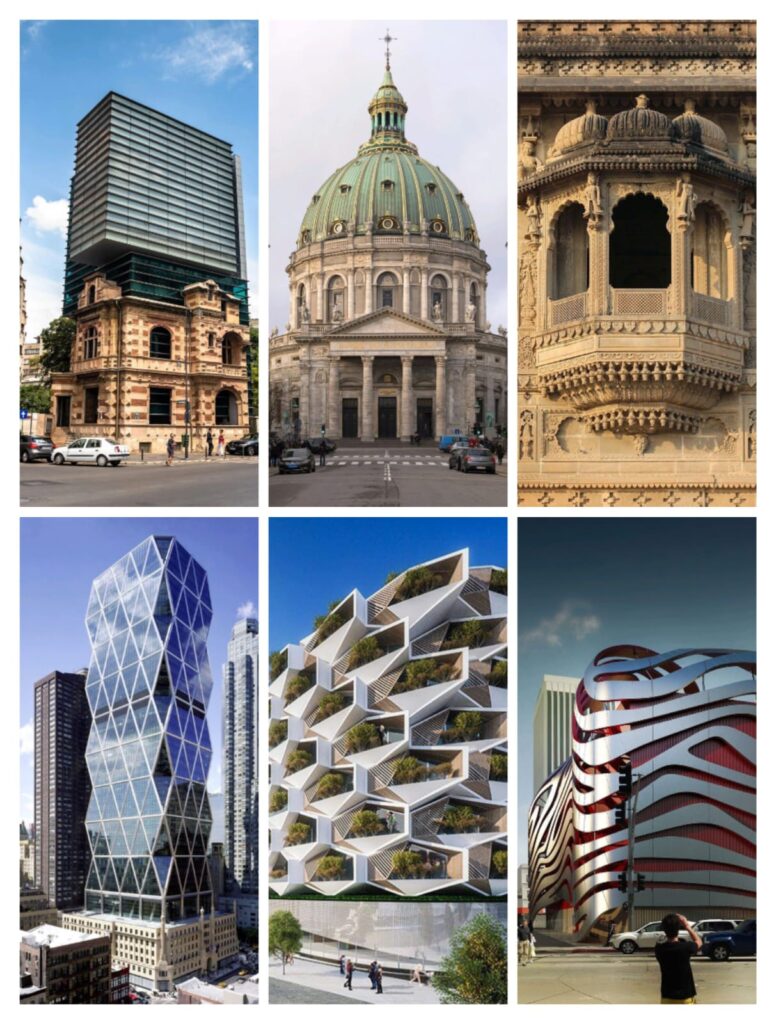Exploring the Timeless Beauty: Contrasting Modern and Old Architectures !
Architecture is not merely about constructing buildings; it is a reflection of society’s values, aspirations, and cultural identity. Over the centuries, architectural styles have evolved, reflecting changes in technology, materials, and social dynamics. In this blog, we’ll delve into the contrasting characteristics of modern and old architectures, exploring their unique features, historical significance, and enduring appeal.
Old Architecture: A Testament to Tradition and Timelessness
Old architecture, often referred to as historical or traditional architecture, encompasses a diverse range of styles and structures spanning different periods and civilizations. From ancient monuments to medieval cathedrals and Renaissance palaces, old architecture embodies craftsmanship, cultural heritage, and architectural mastery.
- Historical Significance: Old architecture represents the rich tapestry of human history, preserving the legacy of past civilizations and their architectural achievements. Landmarks such as the Pyramids of Giza, the Parthenon, and the Colosseum serve as enduring symbols of cultural identity and heritage, attracting millions of visitors from around the world.
- Craftsmanship and Detail: Old architecture is characterized by meticulous craftsmanship and attention to detail, evident in intricate ornamentation, decorative motifs, and handcrafted materials. From stone carvings to stained glass windows, old buildings showcase the skill and ingenuity of artisans who painstakingly crafted these architectural marvels.
- Cultural Identity: Old architecture reflects the cultural identity and values of societies, embodying their religious beliefs, political ideologies, and social structures. Gothic cathedrals, for example, express the spiritual aspirations of medieval Europe, while Islamic mosques showcase the beauty of geometric patterns and arabesque designs.
- Timeless Beauty: Despite the passage of time, old architecture retains its timeless beauty and aesthetic appeal, captivating admirers with its grandeur and elegance. The enduring charm of ancient temples, medieval castles, and Renaissance palazzos continues to inspire awe and admiration, transcending temporal boundaries. Modern Architecture: Pushing Boundaries and Embracing Innovation
Modern architecture, also known as contemporary architecture, represents a departure from traditional styles, embracing new materials, technologies, and design principles. From skyscrapers to avant-garde museums and minimalist residences, modern architecture embodies innovation, functionality, and forward-thinking design.
- Innovative Design: Modern architecture is characterized by innovative design concepts and experimentation with form, function, and materials. Architects push the boundaries of conventional aesthetics, exploring new geometries, structural systems, and spatial arrangements to create dynamic and visually striking buildings.
- Functionality and Efficiency: Modern architecture prioritizes functionality, efficiency, and sustainability, responding to the needs of contemporary society and the challenges of urbanization. Green building practices, energy-efficient designs, and sustainable materials are integral to modern architectural projects, promoting environmental stewardship and resource conservation.
- Urban Landmarks: Modern skyscrapers and iconic landmarks define the urban landscape, symbolizing progress, innovation, and economic prosperity. From the Burj Khalifa in Dubai to the Guggenheim Museum in Bilbao, modern architectural masterpieces redefine city skylines and serve as symbols of cultural identity and urban renewal.
- Adaptive Reuse: Modern architects embrace adaptive reuse and preservation practices, repurposing old buildings and industrial sites for new uses while preserving their historical and architectural significance. Adaptive reuse projects breathe new life into historic structures, transforming them into vibrant cultural hubs, mixed-use developments, and community spaces. Bridging the Gap: Harmonizing Tradition and Innovation
While old and modern architectures may seem distinct, they are not mutually exclusive; rather, they exist on a continuum, each influencing the other and contributing to the rich tapestry of architectural expression. Architects often draw inspiration from historical precedents while embracing innovative technologies and design approaches, creating buildings that honor tradition while embracing the future.
- Historical Context: Understanding the historical context and cultural significance of old architecture is essential for informing contemporary design decisions and fostering a sense of continuity with the past. Architects study ancient building techniques, traditional materials, and historical precedents to create buildings that resonate with their surroundings and reflect local heritage.
- Contextual Integration: Modern architects strive to integrate new buildings harmoniously within their urban and natural environments, respecting the scale, rhythm, and character of existing structures. Contextual design principles guide site planning, massing, and material selection, ensuring that new developments complement rather than dominate their surroundings.
- Cultural Preservation: Preserving and celebrating cultural heritage is integral to sustainable development and social cohesion. Adaptive reuse projects, heritage conservation efforts, and cultural heritage tourism initiatives contribute to the preservation of old architecture and the revitalization of historic urban areas, fostering a sense of pride and identity within communities. Conclusion: Embracing the Past, Designing the Future
Old and modern architectures represent two distinct yet interconnected strands of architectural evolution, each contributing to the diversity, richness, and beauty of the built environment. While old architecture celebrates tradition, craftsmanship, and cultural heritage, modern architecture embraces innovation, functionality, and sustainability. By bridging the gap between tradition and innovation, architects can create buildings that resonate with the past while shaping the future, fostering a dynamic and inclusive architectural landscape that reflects the values and aspirations of society.
